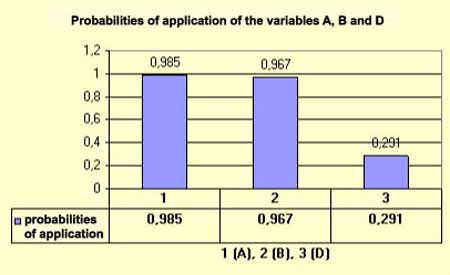 |
Figure 2. Percentages of
application of dependent variables
 5. Conclusions
5. Conclusions
From a descriptive
point of view, we have discussed the character of the intradialectal transitional area of
the speech of the Conca de Tremp, predominated by the maintenance of the main, common
vocalic and consonantal characteristics in north-western Catalan, with the important
existence of certain signs of linguistic change that could be being generalised in some
verbal endings. Likewise, at a morphosyntactic level, we are witnessing an advance in the
more general forms, whether prescriptive, standard or prestigious.
While delving
deeply into the behaviour of the morphological aspects discussed here, as regards the
situation of the processes of linguistic change, we have seen how the full variants lo/los
of the masculine definite article and me, te, se of the singular weak pronouns
maintain an almost testimonial presence in oral use of formal situations of the speech of
the Conca de Tremp, given the extremely high probabilities of loss obtained. The process
of implanting the reinforced variants proper to general use, used in education and by the
press and, hence, highly available, are favoured by the factors of prepared speech,
university education & knowledge of written Catalan, and preceding vocalic
context. The analogical variant of the first person mos is also involved in a
process of advanced change, despite the fact that the percentage data confer it a certain
vitality particularly associated with spontaneous speech and informants with secondary
education or professional training who lack competence in written Catalan. This situation
is duplicated in the case of variants in u of possessive feminine adjectives, since
the influence of innovating and conservative factors that we have discussed is similar. In
this context, only the percentage of loss differs – it is lower than in the variable
of first person plural weak pronouns – and the fact that we are dealing with phonetic
variants. This aspect is common to the feature that has been proven to be the most
conservative, but which is circumscribed exclusively to the area of the Conca de Tremp,
Pallarès and Ribagorçà. Effectively, the alternation between voiced and voiceless
variants of demonstrative adjectives seems not to translate into rapid advances of the
process of substitution due to educational influence, the press or written language,
although the probabilistic results do suggest the favouring of the application of the
variable of the factors of prepared speech and informants aged under 30.
6.
Bibliography
ALAMON, F.;
ANDREU, M. (1992): "Aportació a la fonètica del català nord-occidental". Collegats
5, 355-369.
ALCOVER, A. M.;
MOLL, F. de B. (1929-1932): La flexió verbal en els dialectes catalans. Barcelona:
Publicacions de l’Oficina Romànica, fasc. I-IV.
ALCOVER, A. M.;
MOLL, F. de B. (1930-1962): Diccionari català-valencià-balear. Palma de Mallorca:
Editorial Moll, 10 vol.
ALDC. Atlas
Lingüístic del Domini Català. Enquestes a poblacions i base de dades per preguntes.
Institut d’Estudis Catalans. [Consulta de material inèdit, setembre de 2000].
ANDREVA, G.;
RAMONEDA, R.; TOLDRÀ, R. (1992): "El pallarès a la Vall d’Àssua". Collegats
5, 369-380.
BARRULL, A.;
SISTAC, R. (1992): "Fronteres polítiques i dialectals a la Terreta
(Ribagorça)". A: AA.DD. 3, Segon Congrés Internacional de la Llengua Catalana.
Lingüística Social. Palma de Mallorca: Universitat de les Illes Balears, 51-62.
També reproduït a (1987): Collegats 1, 87-98.
BIBILONI, G.
(1997): Llengua estàndard i variació lingüística. València: Tres i Quatre.
CASANOVAS, M.;
CREUS, I. (1999): "Apunts sobre el lleidatà: fonètica i morfosintaxi". Zeitschrift
für Katalanistik. Revista d’Estudis Catalans 12 (Tübingen, 1999), 83-108.
COLL, P. (1990):
"El parlar del Pallars". Ilerda/Humanitats XLVIII. 2a època, 197-200.
COLL, P. (1991): El
parlar del Pallars. Barcelona: Empúries.
COROMINES, J.
(1935): "El parlar de Cardós i Vall Ferrera". Butlletí de Dialectologia
Catalana XXIII, 241-331. Reproduït a COROMINES, J. (1976): Entre dos llenguatges.
Barcelona: Curial edicions, 29-67. |
